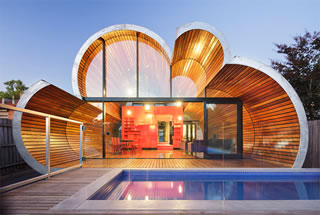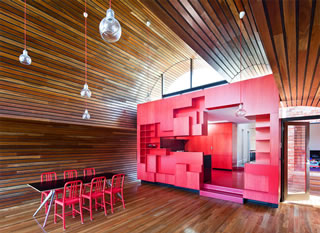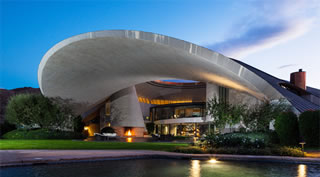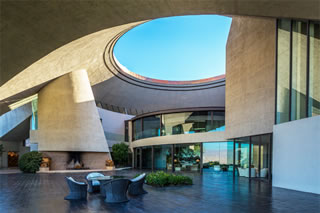Going Wild!
From the beginning and at its very core, modern architecture is puritanical. Less is more. Structure should be shown in an honest manner. Decoration is disease.
But that doesn't mean modern architects lack a sense of flair—or humor.
Modern architects, beginning with the pioneers, have designed buildings with sexy curves (Eric Mendelsohn), apparently without walls (Mies van der Rohe), and with strange angles and bridge-like cantilevers (Frank Lloyd Wright).
And modernists have gotten very good at explaining—with charts, diagrams, and at times with tedious essays—why their wildest-looking houses are in fact all about function rather than fantasy.
Curves fend off fire, they say. And what greater architect to use as inspiration than God, who designed for snails their shell and bees their hive?
Few, if any, modern architects would ever tell you that they have set out to design a house that is 'wild.' But what else would you call these?
In an effort to plumb the farther shores of modern residential design, CA-Modern has taken upon itself the challenge of presenting to its readers 12 of the wildest modern houses ever created.
Note that several of them are brand new, which foretells—what?
 |
 |
1. Cloud House
Built: 2012
Architect: The firm McBride Charles Ryan
Where: Fitzroy North, near Melbourne, Australia
Who hasn't dreamed of living in a cloud, surrounded not by walls but by wisps of white? The Cloud House, with its compound curves and cedar plank walls, doesn't quite achieve that—but it plays with the idea.
Not every wild house has to stop traffic—or even be visible from the street. This almost child-like home addition—the couple who commissioned it have two children—hides behind a single-story Edwardian home on a street of similar homes.
The architects' first proposal for the addition was "too staid," the homeowners objected.
That can't be said about the final result. The architects divided their cloud addition into two sections, one for cooking and dining, the other for entertaining and play. The kitchen, which divides the two, is essentially a brightly painted red box that is inserted within the cloud shell.
Playful the Cloud House may be but, according to the architects, the shape is entirely—well, maybe not entirely—functional.
The roof's curves, they point out, dampen the noise caused by the wooden floors.
 |
 |
2. Bob Hope House
Built: Designed 1973, completed 1980
Architect: John Lautner
Where: Palm Springs
He's best known for his Chemosphere, a floating home in the Los Angeles hills that looks to many like a flying saucer.
The 22,366-square-foot Bob Hope House, with six bedrooms, a dining room seating 300, a pool shaped like Bob Hope's hook-nosed profile, and a rock jutting into the living room, was one of his grandest houses.
Ever the storyteller, Lautner designed the swooping roof to suggest a volcano, its mouth forming a skylight over a garden. To some viewers the roof suggests a mushroom.
But the house had a story of its own, and to Lautner, at least, it did not have a happy ending. Lautner called Hope "the client from hell," a fire destroyed much of the house during construction, leading to delays, and later changes by Hope's wife caused Lautner to disown the house.
But it continues to dazzle.




